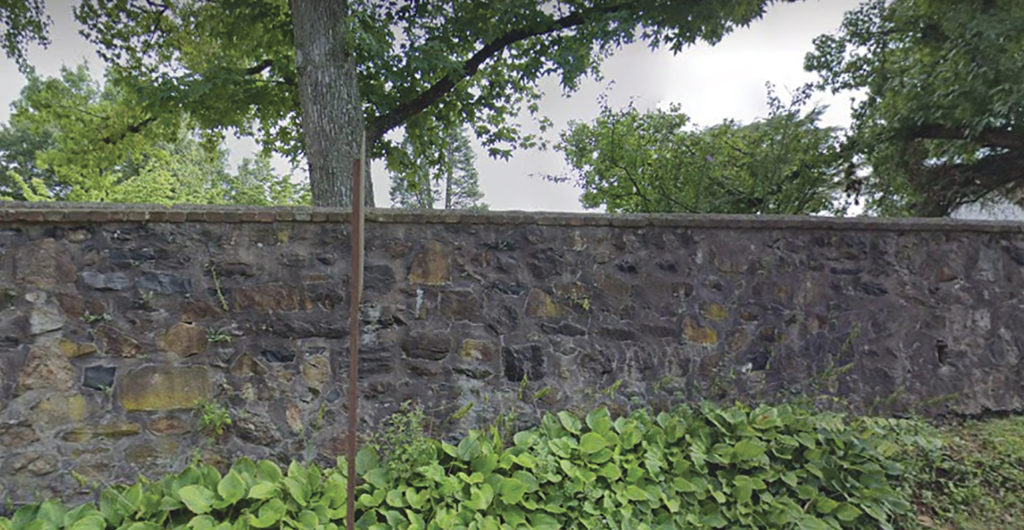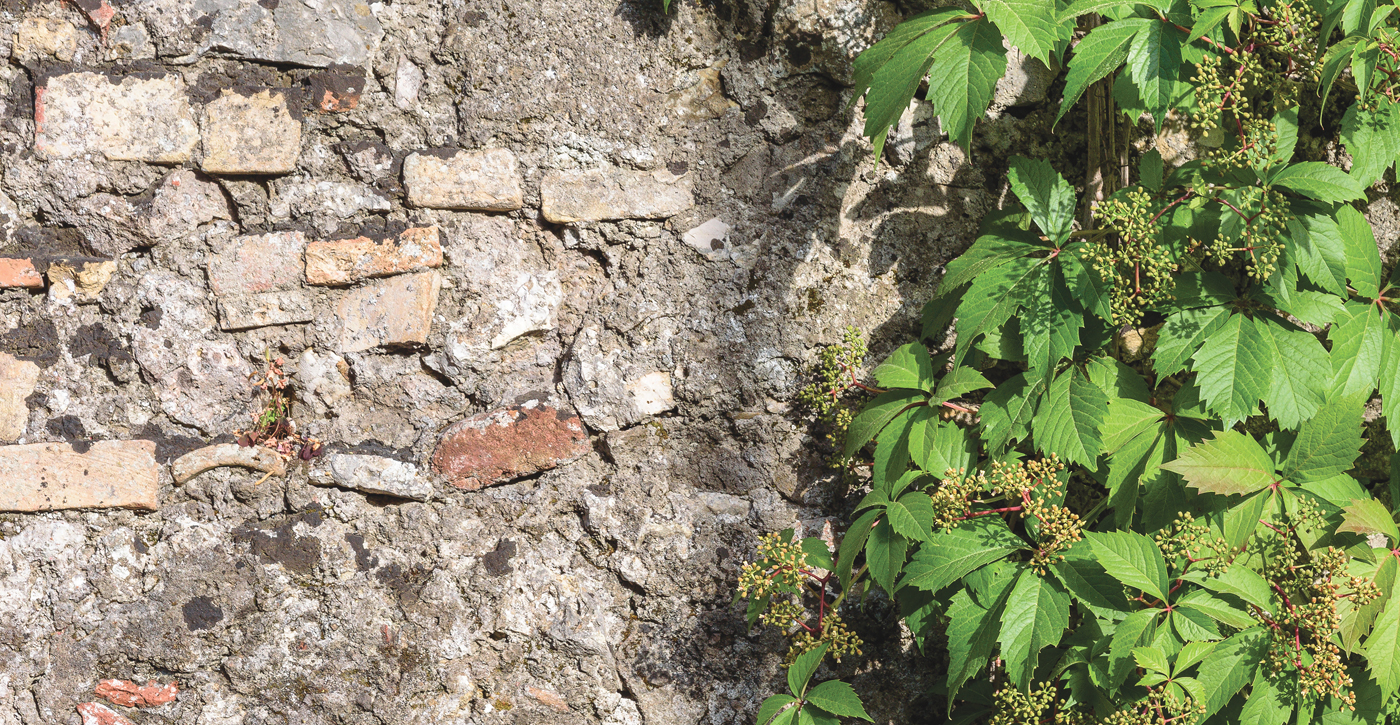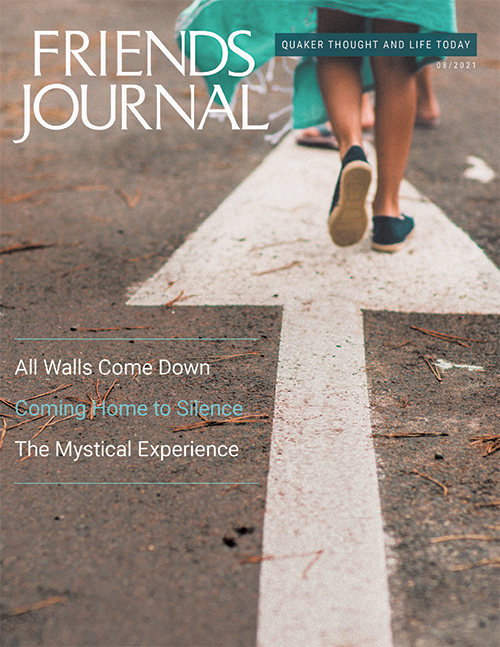Where Physics and Spirituality Overlap
When part of an old stone wall outside our meetinghouse recently collapsed, I thought of my father, who died suddenly a little over ten years ago. As I was sitting with him one Sunday afternoon about three months before he passed away, he spoke about his plans for the coming year, but with a caveat: “unless the roof falls in.” I knew he was speaking metaphorically about his health, which had been relatively good for about a decade after triple bypass surgery. I sensed that he felt vulnerable, as though he knew something was wearing down within. My father had a strong faith and often said that he was comfortable that God would decide when it was “his time.” He would look me in the eye and say plainly, “David, remember, this body is not me.” I knew what he meant: that his immortal soul was his essence. His body would dissolve, but his soul would abide. It was a comfort.
Nevertheless, my father’s death shook me and our family, as the loss of a loved one generally does. When part of the wall outside our beautiful old meetinghouse fell, I saw a metaphor in the ruins and felt a familiar rattle. The rubble was a reminder of the powerful forces of erosion, change, upheaval, and loss that live alongside all that we cherish. It was a reminder that such unravelings are often hidden from view as they are unfolding, like the initial silent spread of the pandemic last year.
The stone wall at our meetinghouse looked, well, just like a stone wall, with all of the stability that old boulders motionless in mortar convey. Yet deep within that seeming solidity, something was coming apart. After years of moisture creeping in, freezing, expanding, contracting, cracking, breaking . . . the system reached a tipping point and collapsed in an instant, revealing the chaos that had been building inside.
Physicists have a fancy word for this tendency of stuff to come undone. They call it “entropy,” a feature of the Second Law of Thermodynamics: a measure of the disorder, the randomness, within a system. Science holds that unless energy is added to a closed system, entropy increases over time.
We know this intuitively. The papers on our desks don’t spontaneously organize themselves. Eventually the roof leaks. Walls cave in. People grow old and die. As the poet Yeats wrote, “Things fall apart; the centre cannot hold.”
What is the meaning of life and the purpose of creation itself? Why rebuild the meetinghouse wall knowing where it ends? Why not fully accept impermanence and let entropy have its way?
As our meeting’s caring members went to work securing what was left of our wall, clearing the rubble and making plans to rebuild, I began to reflect on the forces that move counter to entropy in the universe. Insofar as it perpetuates its own patterns of order, life runs counter to entropy. Life itself does not violate the Second Law of Thermodynamics; it creates organization in the face of entropy by drawing in and investing energy in its internal order, but increasing disorder elsewhere. Stop breathing or eating, and entropy accelerates. Living beings constantly take in energy, exchanging it for waste, just as clearing one’s desk generally involves creating trash. Life can run counter to entropy because of the massive energy that the earth receives from the sun. In the universe as a whole, entropy still increases. We can think of climate change, with all of its incipient chaos, as the entropy externalized by the accelerating organized growth of human civilization.
Here physics and spirituality might overlap. In terms of modern cosmology, it is consistent with the Big Bang theory to think about the universe as a wind-up clock. Somewhere near the beginning of time, the universe achieved an extreme state of low entropy, of hyper-organization and nonrandomness. Imagine a kind of singular, primordial star with super-organized light. As a Quaker, it is easy for me to imagine a state of original spiritual energy and unity. Life’s organizing energy derives from this early state of order. All of the organizing force in the universe can be understood as drawing on that first energy; dare we call it “the Light within”?
The movement of life and living social systems toward order also gives rise to complexity, featuring structure and hierarchy. Our meetinghouse wall was both ordered and complex, involving an elaborate pattern of stones of different sizes carefully assembled and unified by the masons who built it. The complexity of that wall was similar but also different from the living systems around it: the trees and grass and creatures that lived around the wall and even within it. Life has a kind of superpower that stones lack. Biologists call it autopoiesis, the ability to regenerate and replicate form in the encounter with a changing environment. Lacking this ability to self-renew, our wall couldn’t resist the entropy mounting inside.
Complexity itself is an emergent feature of our universe, involving a dance that unfolds between order and disorder, between systems that are predictable and uniform but also feature highly irregular and uncertain dynamics. We know exactly when the sun will rise every day but cannot easily predict the weather systems that it will produce a few days hence. The extreme interdependence of variables, along with systemic feedback, makes precise prediction of the weather impossible. Complexity seems to result from the engagement of strong organizing forces with the background chaos in the universe. In this way, complexity is part of the larger force of entropy unfolding in creation. Quakers planned and built that wall years ago, but none could say exactly when it would tumble down.
Genesis says: “dust you are and to dust you will return,” a reminder that entropy itself is one of God’s laws, that we may find something spiritual in entropy. The randomness of stone ruins has a certain beauty, showing even in the ruins of our wall. Over time, the unpredictable flow of winds, rain, and rivers sculpt graceful forms into canyon rocks. In the natural unwinding of structures, eternity unfolding becomes visible. Yes, we will become dust eventually, but in between the beginning dust and ending dust, we might be—for some time at least—a beautiful stone wall, a member of a Quaker meeting that mends that wall, or a bird that nests on it.
The physicists tell us that eventually the clock of the universe will completely unwind. All complex structures will dissolve; all life and complexity will unravel and dissipate. Knowing that, we might well wonder, what is the point of organizing anything? What is the meaning of life and the purpose of creation itself? Why rebuild the meetinghouse wall knowing where it ends? Why not fully accept impermanence and let entropy have its way? One thinks of Sisyphus rolling the stone up the hill, only to watch it roll back down.

Radnor Friends Meeting Wall. Google Street View.
Impermanence, entropy, futility, and death itself had been a strong focus of my spiritual contemplation when our wall collapsed. In the preceding weeks, our meeting had sponsored my participation in a course on mindfulness meditation. Like many Quakers, I am the kind of person who tries to be engaged in intentional, creative transformation of the world. I am pursuing justice; I am concerned; I am active; I am busy trying to increase love and healing where I can. I am deeply concerned about the development of people, institutions, and communities toward justice—through love, peace, and harmony. My mindfulness class asked me to cease all such effort, to sit still for a time and just benevolently contemplate myself and the world simply as we are. Let go of striving! This was very challenging.
After many hours of struggle with observation and reflection, including many distractions and detours in my mind to the past and future, I experienced much that I knew intellectually but observed it all in a more visceral and strangely less disturbing way. I saw the chaos and increasing disorder in the world, the growth of hierarchy, the violence, the unchecked spread of human systems and their vast existing and potential destruction of one another, of all life on Earth. I saw the absurd smallness of my own efforts in this massive swirling system. I saw that my striving often prevented me from attaining a sense of peace and joy in the present moment. Yet I also saw meaning in the work of love, hope, and community, and so many Light-driven spirits moving toward justice, peace, and wholeness. I saw the arc of the moral universe as open and holding potential. And I felt that the physical world, so mired in complexity and chaos—and still tending toward entropy—was nevertheless deeply connected to the spiritual world, somehow bound up with, even expressing, the primordial order that still energizes life and its quest for beauty and healing. Our meetinghouse wall—its creation, its undoing, and its potential rebuilding—exemplified the cosmic dance of God’s creation.
We are only conscious for an infinitesimal fraction of cosmological time, as individuals, as a species, and as part of life on Earth as a whole. Maybe that’s the point: that the fleeting process of healing and mending the physical world—of taking care of one another during our inevitable decline—draws us to contemplate the spirit. And here there seems to be a paradox. Entropy is part of God’s will, but so are the forces that run against it.
I felt that the physical world, so mired in complexity and chaos—and still tending toward entropy—was nevertheless deeply connected to the spiritual world, somehow bound up with, even expressing, the primordial order that still energizes life and its quest for beauty and healing.
Quakers often speak of the connection between Spirit, Light, and Love. Was it actually love that was the theoretical primordial order at the beginning of time? Might that energy of love at the beginning transcend entropy? I think of George Fox and his ocean of darkness and ocean of light: “I saw also that there was an ocean of darkness and death, but an infinite ocean of light and love, which flowed over the ocean of darkness.” Where does love come from, if not from God? Maybe God’s love was bound up in that original order, the winding up of the universe. Love is a healing, nurturing energy that attends to form and order, that engenders beauty in the world. As I think about our Quaker values, I see that they all run counter to entropy. Peace, compared to violence, reduces disorder. Community is the unity we create from diversity, increasing love and peace, and thus order. Simplicity is deeply related to order. Things that are simple are more orderly. The quest to simplify complexity entails a deep process of ordering. To make things simple and clear requires significant energy investment. Equality requires and exhibits order. The tendency within systems that exhibit inequality is to break simple order and move toward hierarchy, which requires power and violence to be maintained; violence increases entropy. Stewardship and sustainability imply a commitment to preserving order, form, and beauty in the world. Integrity implies ordered unity and fidelity to values. Similarly, we cannot understand integrity without order and stability.
With help from the spirit, we Quakers will restore our wall and, after many years, God’s Second Law of Thermodynamics will surely lay it down again. But I have faith that the loving energy that restores our wall, and that informs our values, comes from somewhere eternal and transcendent, beyond this universe. And as we focus our energies on preserving and rebuilding our walls, bodies, and communities, in a dance with ultimate futility, let us also lovingly tend to the Spirit that is the root of our root, our tether to the dawn before creation, and also to heaven beyond it. We are dust and will return to dust, but in our every atom, we also carry the Divine Spark.




I don’t know if anything could be added to this… a wonderful essay!!! These are the reasons why we do what we do and believe in what we believe… thank you…
Oh, thank you for what you wrote that was shared today on Friends Journal. So much good in that to continue to think through. Some of my favorite lines were “this body is not me” and “we will restore our wall and… (God) will surely lay it down again” and “we might well wonder, what is the point…?” And “such unravelings are often hidden from view as they are unfolding.” SO much beautiful insight and wisdom and contemplation. Striving verses the meaning of work. Doing in combination with not doing.
This essay does not try to hide from the complexity of life and love. Some would like “tidy” answers that make us feel good. The discussion is challenging and often discomforting. Perhaps it makes us go deeper.
What a beautiful reflection – thank you.
We are embedded in paradox and sadly the West abandoned this centuries ago and replaced it with reason and logic. The dominant discourse still demands a perspective of either/or rather than a perspective both/and.
Spirituality is the bed-rock of paradox, both/and. Thanks again for reminding us of our paradoxical orientations.
Very interesting the two opposing threads of existence, entropy/destruction and love/creativity. As a product of the love/creativity thread I’m naturally much more interested in the things of that thread than the things of the entropy/destruction thread but that is not true for everybody. For nearly all of my working life I worked for a computer supplier as a systems support person. Mainframe computers demand long term relationships with your customers so the support staff were each allocated a set of customers to look after. Now some of our customers were in the arms industry so belonged to the entropy/destruction thread. In business things change all the time and in one of our periodic internal restructurings I was allocated a major arms manufacturer to support. I knew at once that I did not want to take on the support of this particular customer but would I lose my job as a result, I didn’t know. Eventually i gathered up my courage and told my manager that as matter of conscience I simply could not support an arms manufacturer. Luckily he understood my position and allocated this customer to another member of staff who was more than happy to have this responsibility and seemed to flourish in it.Johannesburg
Beautiful reflection, with your words I have meditated on the density of matter and the slightest forms of the spirit. Nothing remains, everything changes. I have nothing to fear when I am connected to God.
This ministry has such depth–written with such beauty. I have been drawn to similar topics of Spirit. I was very struck by this video–describing chemically what exactly life and death are. I similarly find it nestles perfectly within Quaker thought. I would be happy to discuss further. https://www.youtube.com/watch?v=ibpdNqrtar0